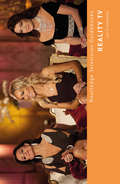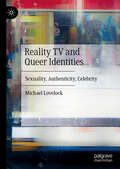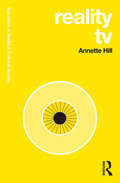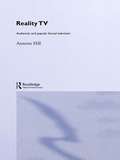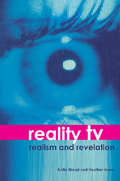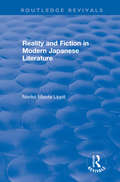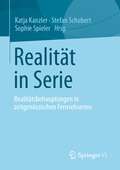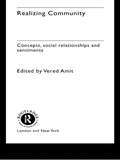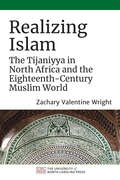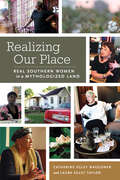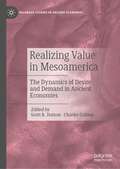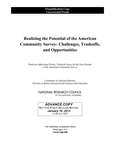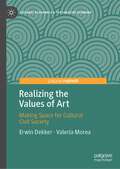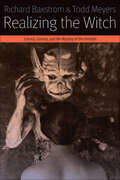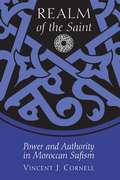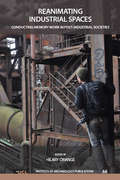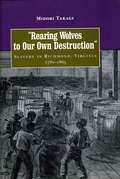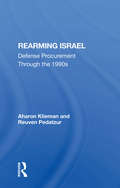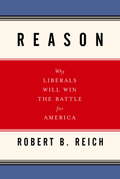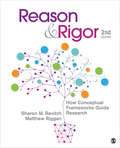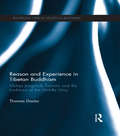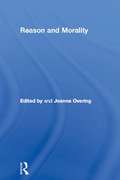- Table View
- List View
Reality TV
by Laurie Ouellette Susan MurraySurvivor. The Bachelor. Extreme Makeover. Big Brother. Joe Millionaire. American Idol. The Osbournes. It is virtually impossible to turn on a television without coming across some sort of reality programming. Yet, while this genre has rapidly moved from the fringes of television culture to its lucrative core, critical attention has not kept pace. Beginning by unearthing its historical roots in early reality shows like Candid Camera and wending its way through An American Family, Cops, and The Real World to the most recent crop of reality programs, Reality TV is the first book to address the economic, visual, cultural, and audience dimensions of reality television. The essays provide a complex and comprehensive picture of how and why this genre emerged, what it means, how it differs from earlier television programming, and how it engages societies, industries, and individuals. Topics range from the construction of televisual "reality" to the changing face of criminal violence on TV, to issues of surveillance, taste, and social control. By spanning reality television's origins in the late 1940s to its current overwhelming popularity, Reality TV demonstrates both the tenacity of the format and its enduring ability to speak to our changing political and social desires and anxieties. Contributors include: Nick Couldry, Mary Beth Haralovich, John Hartley, Chuck Kleinhans, Derek Kompare, Jon Kraszewski, Kathleen LeBesco, Justin Lewis, Ted Magder, Jennifer Maher, Anna McCarthy, Rick Morris, Chad Raphael, Elayne Rapping, Jeffrey Sconce, Michael W. Trosset, Pamela Wilson.
Reality TV (Routledge Television Guidebooks)
by Jon KraszewskiFrom early first-wave programs such as Candid Camera, An American Family, and The Real World to the shows on our television screens and portable devices today, reality television consistently takes us to cities—such as New York, Los Angeles, and Boston—to imagine the place of urbanity in American culture and society. Jon Kraszewski offers the first extended account of this phenomenon, as he makes the politics of urban space the center of his history and theory of reality television. Kraszewski situates reality television in a larger economic transformation that started in the 1980s when America went from an industrial economy, when cities were home to all classes, to its post-industrial economy as cities became key points in a web of global financing, expelling all economic classes except the elite and the poor. Reality television in the industrial era reworked social relationships based on class, race, and gender for liberatory purposes, which resulted in an egalitarian ethos in the genre. However, reality television of the post-industrial era attempts to convince viewers that cities still serve their interests, even though most viewers find city life today economically untenable. Each chapter uses a key theoretical concept from spatial theory—such as power geometries, diasporic nostalgia, orientalism, the imagination of social expulsions, and the relationship between the country and the city—to illuminate the way reality television engages this larger transformation of urban space in America.
Reality TV and Queer Identities: Sexuality, Authenticity, Celebrity
by Michael LovelockThis book examines queer visibility in reality television, which is arguably the most prolific space of gay, lesbian, transgender and otherwise queer media representation. It explores almost two decades of reality programming, from Big Brother to I Am Cait, American Idol to RuPaul’s Drag Race, arguing that the specific conventions of reality TV—its intimacy and emotion, its investments in celebrity and the ideal of authenticity—have inextricably shaped the ways in which queer people have become visible in reality shows. By challenging popular judgements on reality shows as damaging spaces of queer representation, this book argues that reality TV has pioneered a unique form of queer-inclusive broadcasting, where a desire for authenticity, rather than being heterosexual, is the norm. Across all chapters, this book investigates how reality TV’s celebration of ‘compulsory authenticity’ has circulated ‘acceptable’ and ‘unacceptable’ ways of being queer, demonstrating how possibilities for queer visibility are shaped by broader anxieties and around selfhood, identity and the real in contemporary cultural life.
Reality TV: Factual Entertainment And Television Audiences (Key Ideas in Media & Cultural Studies)
by Annette HillReality TV is popular entertainment. And yet a common way to start a conversation about it is ‘I wouldn’t want anyone to know this but…’ Why do people love and love to hate reality TV? This book explores reality TV in all its forms - from competitive talent shows to reality soaps - examining a range of programmes from the mundane to those that revel in the spectacle of excess. Annette Hill’s research draws on interviews with television producers on the market of reality TV and audience research with over fifteen thousand participants during a fifteen year period. Key themes in the book include the phenomenon of reality TV as a new kind of inter-generic space; the rise of reality entertainment formats and producer intervention; audiences, fans and anti-fans; the spectacle of reality and sports entertainment; and the ways real people and celebrities perform themselves in cross-media content. Reality TV explores how this form of popular entertainment invites audiences to riff on reality, to debate and reject reality claims, making it ideal for students of media and cultural studies seeking a broader understanding of how media connects with trends in society and culture.
Reality TV: Factual Entertainment and Television Audiences (Key Ideas In Media And Cultural Studies)
by Annette HillReality TV restores a crucial, and often absent, element to the critical debate about reality television: the voices of people who watch reality programmes. From Animal Hospital to Big Brother, Annette Hill argues that much can be learned from listening to audience discussion about this popular and rapidly changing television genre. Viewers' responses to reality TV can provide invaluable information to enhance our understanding of both the reality genre and contemporary television audiences. Drawing on quantitative and qualitative audience research to understand how viewers categorise the reality genre, and how they judge the performance of ordinary people and the representation of authenticity within different types of reality programmes. * Do audiences think reality TV is real? * Can people learn from watching reality TV? * How critical are viewers of reality TV? Reality TV argues that audiences are engaged in a critical examination of the development of popular factual television. The book examines how audiences can learn from watching reality programmes, and how viewers think and talk about the ethics of reality TV.
Reality TV: Realism and Revelation
by Biressi Anita Heather NunnReality television has little to do with reality and everything to do with television form and content. Reality TV: Realism and Revelation takes the reality television phenomenon to be a significant movement within documentary and factual programming. This book analyses new and hybrid genres including observational documentaries, talk shows, game shows, docu-soaps, dramatic reconstructions, law and order programming and 24/7 formats such as Big Brother and Survivor. These programmes are both popular with audiences and heavily debated in the media; they are at the centre of heated discussions about tabloidisation, media ethics, voyeurism and the representation of the real. Through detailed case studies this book breaks new ground by linking together two major themes: the production of realism and its relationship to revelation. It addresses 'truth telling', confession and the production of knowledges about the self and its place in the world.
Reality TV: Realism and Revelation (Television Studies)
by Heather Nunn Anita BiressiThis book analyses new and hybrid genres of television including observational documentaries, talk shows, game shows, docu-soaps, dramatic reconstructions, law and order programming and 24/7 formats such as Big Brother and Survivor.
Reality and Fiction in Modern Japanese Literature (Routledge Revivals)
by Noriko Mizuta LippitThis title was first published in 1980. In twentieth century Japanese literature, the opposition and interaction of realism and romanticism on the level of literary concepts, and of Marxism and aestheticism (including, in part, modernism) on the level of literary ideology, supplies a most vital basis for writers searching for new methods of literary expression, fostering debates among the writers and creating the setting for active experimentation with style, form and language. This study is a result of an extended stay in the United States by the author who turned increasingly toward questioning and evaluating my own relation to Japan's literary heritage. For Japanese who have witnessed (at least intellectually) the violent attraction to and rejection of foreign cultures of many of their predecessors in the Meiji, Taisho and Showa eras, and their final, often sentimental and abstract, glorification of the Japanese cultural heritage, nihon kaiki (return to Japan) still presents enormously complex intellectual as well as emotional problems.
Realität in Serie: Realitätsbehauptungen in zeitgenössischen Fernsehserien
by Katja Kanzler Sophie Spieler Stefan SchubertRealität(streue) ist ein markantes Thema in der Medienkultur des 21. Jahrhunderts, das sich auf widersprüchliche Weise entfaltet: Realness scheint derzeit sowohl eine Krise als auch eine Konjunktur zu erleben. Der vorliegende Band beleuchtet dieses Thema im medialen Kontext der Fernsehserie mit Hilfe von Fallstudien aus interdisziplinären Perspektiven. Im Mittelpunkt stehen dabei die sozialen, kulturellen, politischen und ästhetischen Potenziale von Realitätsbehauptungen und -effekten in seriellen Fernsehformaten.
Realizing Community: Concepts, Social Relationships and Sentiments (European Association of Social Anthropologists)
by Vered Amit'Community' is so overused both in everyday language as well as in scholarly work that it could easily be dismissed as a truism. However, the persistence of the term itself shows that the idea continues to resonate powerfully in our daily lives, ethnographic accounts as well as theoretical analyses. This book returns a timely and concerted anthropological gaze to community as part of a broader consideration of contemporary circumstances of social affiliation and solidarity.
Realizing Islam: The Tijaniyya in North Africa and the Eighteenth-Century Muslim World (Islamic Civilization and Muslim Networks)
by Zachary Valentine WrightThe Tijaniyya is the largest Sufi order in West and North Africa. In this unprecedented analysis of the Tijaniyya's origins and development in the late eighteenth century, Zachary Valentine Wright situates the order within the broader intellectual history of Islam in the early modern period. Introducing the group's founder, Ahmad al-Tijani (1737–1815), Wright focuses on the wider network in which al-Tijani traveled, revealing it to be a veritable global Islamic revival whose scholars commanded large followings, shared key ideas, and produced literature read widely throughout the Muslim world. They were linked through chains of knowledge transmission from which emerged vibrant discourses of renewal in the face of perceived social and political corruption. Wright argues that this constellation of remarkable Muslim intellectuals, despite the uncertainly of the age, promoted personal verification in religious learning. With distinctive concern for the notions of human actualization and a universal human condition, the Tijaniyya emphasized the importance of the realization of Muslim identity. Since its beginnings in North Africa in the eighteenth century, the Tijaniyya has quietly expanded its influence beyond Africa, with significant populations in the Middle East, Southeast Asia, and North America. We are proud to offer this book in our usual print and ebook formats, plus as an open-access edition available through the Sustainable History Monograph Project.
Realizing Our Place: Real Southern Women in a Mythologized Land
by Catherine Egley Waggoner Laura Egley TaylorWhat does it mean to be from somewhere? Does place seep into one's very being like roots making their way through rich soil, shaping a sense of self? In particular, what does it mean to be from a place with a storied past, one mythologized as the very best and worst of our nation? Such questions inspired Catherine Egley Waggoner and Laura Egley Taylor, sisters and Delta expatriates themselves, to embark on a trail of conversations through the Mississippi Delta.Meeting in evocative settings from kitchens and beauty parlors to screened-in porches with fifty-one women--black, Chinese, Lebanese, and white; elderly and young; rich and poor; bisexual and straight--the authors trace the extent to which the historical dimensions of southern womanhood like submissiveness, purity, piety, and domesticity are visible in contemporary Delta women's everyday enactments. Waggoner and Taylor argue that these women do not simply embrace or reject such dimensions, but instead creatively tweak stereotypes in such a way that skillfully legitimizes their authenticity.Blending academic analysis with colorful excerpts of Delta women's words and including over one hundred striking photographs, Waggoner and Taylor provide an insightful peek into the lives of real southern women living in a deeply mythologized land.
Realizing Value in Mesoamerica: The Dynamics of Desire and Demand in Ancient Economies (Palgrave Studies in Ancient Economies)
by Charles Golden Scott R. HutsonThis edited collection addresses concepts of value and its impact on economies and economic decision-making in Mesoamerica. It brings together various theoretical and methodological approaches to illuminate the little-studied topic of value in ancient economies.While scholars increasingly note that tangible objects found in the archaeological record could assume different values, depending on how they were used and circulated, less attention has been paid to how we might infer consensus (or lack of consensus) on how value was determined in past cultures so different from contemporary ones. These contributions show how multiple and conflicting understandings of what is important and meaningful coexist within any society even as moments of exchange create the impression of shared formulations of value. They consider divergences between shared understandings based on systems of beliefs and patterns of practice and the individual decisions of social actors. They also discuss how inequalities in social structures might inform our understanding of value, and how a multiplicity of values might encourage closer inspection of inequality in turn.The book brings together fifteen chapters focused on many parts of Mesoamerica, including Western Mexico, the Basin of Mexico, Veracruz, Oaxaca, and various parts of the Maya Lowlands, and range chronologically from the Classic period (250-900 CE) to the Spanish Conquest in the early 16th Century. It appeals to those working in archaeology, economic anthropology, economic history, and all those interested in how value can be understood in terms of contemporary cultural and political differences.
Realizing the Potential of Immigrant Youth
by Donald J. Hernandez Ann S. Masten Karmela LiebkindThe well-being and productivity of immigrant youth has become one of the most important global issues of our times as a result of mass migration and resettlement. In this unique volume, leading scholars from multiple nations and disciplines provide a state-of-the-art overview of contemporary research on immigrant youth and delineate the most promising future directions for research on their success, suggesting implications for policy and interventions that will benefit host societies as well as immigrant youth. The contributors to Realizing the Potential of Immigrant Youth include many of the leading international experts on migration, acculturation, intergroup issues, and immigrant youth development, with contributions from the fields of child development, demography, economics, education, immigrant mental health, social psychology, and sociology.
Realizing the Potential of the American Community Survey: Challenges, Tradeoffs, and Opportunities
by Panel on Addressing Priority Technical Issues for the Next Decade of the American Community SurveyThe American Community Survey (ACS) was conceptualized as a replacement to the census long form, which collected detailed population and housing data from a sample of the U. S. population, once a decade, as part of the decennial census operations. The long form was traditionally the main source of socio-economic information for areas below the national level. The data provided for small areas, such as counties, municipalities, and neighborhoods is what made the long form unique, and what makes the ACS unique today. Since the successful transition from the decennial long form in 2005, the ACS has become an invaluable resource for many stakeholders, particularly for meeting national and state level data needs. However, due to inadequate sample sizes, a major challenge for the survey is producing reliable estimates for smaller geographic areas, which is a concern because of the unique role fulfilled by the long form, and now the ACS, of providing data with a geographic granularity that no other federal survey could provide. In addition to the primary challenge associated with the reliability of the estimates, this is also a good time to assess other aspects of the survey in order to identify opportunities for refinement based on the experience of the first few years. "Realizing the Potential of the American Community Survey" provides input on ways of improving the ACS, focusing on two priority areas: identifying methods that could improve the quality of the data available for small areas, and suggesting changes that would increase the survey's efficiency in responding to new data needs. This report considers changes that the ACS office should consider over the course of the next few years in order to further improve the ACS data. The recommendations of "Realizing the Potential of the American Community Survey" will help the Census Bureau improve performance in several areas, which may ultimately lead to improved data products as the survey enters its next decade.
Realizing the Values of Art: Making Space for Cultural Civil Society (Cultural Economics & the Creative Economy)
by Erwin Dekker Valeria MoreaThis book provides a novel approach to the understanding and realization of the values of art. It argues that art has often been instrumentalized for state-building, to promote social inclusion of diversity, or for economic purposes such as growth or innovation. To counteract that, the authors study the values that artists and audiences seek to realize in the social practices around the arts. They develop the concept of cultural civil society to analyze how art is practiced and values are realized in creative circles and co-creative communities of spectators. The insights are illustrated with case-studies about hip-hop, Venetian art collectives, dance festivals, science-fiction fandom, and a queer museum. The authors provide a four-stage scheme that illustrates how values are realized in a process of value orientation, imagination, realization, and evaluation.The book relies on an interdisciplinary approach rooted in economics and sociology of the arts, with an appreciation for broader social theories. It integrates these disciplines in a pragmatic approach based on the work of John Dewey and more recent neo-pragmatist work to recover the critical and constructive role that cultural civil society plays in a plural and democratic society. The authors conclude with a new perspective on cultural policy, centered around state neutrality towards the arts and aimed at creating a legal and social framework in which social practices around the arts can flourish and co-exist peacefully.
Realizing the Witch: Science, Cinema, and the Mastery of the Invisible (Forms of Living)
by Richard Baxstrom Todd MeyersBenjamin Christensen’s Häxan (The Witch, 1922) stands as a singular film within the history of cinema. Deftly weaving contemporary scientific analysis and powerfully staged historical scenes of satanic initiation, confession under torture, possession, and persecution, Häxan creatively blends spectacle and argument to provoke a humanist re-evaluation of witchcraft in European history as well as the contemporary treatment of female “hysterics” and the mentally ill.In Realizing the Witch, Baxstrom and Meyers show how Häxan opens a window onto wider debates in the 1920s regarding the relationship of film to scientific evidence, the evolving study of religion from historical and anthropological perspectives, and the complex relations between popular culture, artistic expression, and concepts in medicine and psychology. Häxan is a film that travels along the winding path of art and science rather than between the narrow division of “documentary” and “fiction.” Baxstrom and Meyers reveal how Christensen’s attempt to tame the irrationality of “the witch” risked validating the very "nonsense" that such an effort sought to master and dispel. Häxan is a notorious, genre-bending, excessive cinematic account of the witch in early modern Europe. Realizing the Witch not only illustrates the underrated importance of the film within the canons of classic cinema, it lays bare the relation of the invisible to that which we cannot prove but nevertheless “know” to be there.
Realm of the Saint: Power and Authority in Moroccan Sufism
by Vincent J. CornellIn premodern Moroccan Sufism, sainthood involved not only a closeness to the Divine presence (walaya) but also the exercise of worldly authority (wilaya). The Moroccan Jazuliyya Sufi order used the doctrine that the saint was a "substitute of the prophets" and personification of a universal "Muhammadan Reality" to justify nearly one hundred years of Sufi involvement in Moroccan political life, which led to the creation of the sharifian state.
Reanimating Industrial Spaces: Conducting Memory Work in Post-industrial Societies (UCL Institute of Archaeology Publications #66)
by Hilary OrangeReanimating Industrial Spaces explores the relationships between people and the places of former industry through approaches that incorporate and critique memory-work. The chapters in this volume consider four broad questions: What is the relationship between industrial heritage and memory? How is memory involved in the process of place-making in regards to industrial spaces? What are the strengths and pitfalls of conducting memory-work? What can be learned from cross-disciplinary perspectives and methods? The contributors have created a set of diverse case studies (including iron-smelting in Uganda, Puerto Rican sugar mills and concrete factories in Albania) which examine differing socio-economic contexts and approaches to industrial spaces both in the past and in contemporary society. A range of memory-work is also illustrated: from ethnography, oral history, digital technologies, excavation, and archival and documentary research.
Rearing Wolves to Our Own Destruction: Slavery in Richmond Virginia, 1782-1865 (Carter G. Woodson Institute Series)
by Midori TakagiRICHMOND WAS NOT only the capital of Virginia and of the Confederacy; it was also one of the most industrialized cities south of the Mason-Dixon Line. Boasting ironworks, tobacco processing plants, and flour mills, the city by 1860 drew half of its male workforce from the local slave population. Rearing Wolves to Our Own Destruction examines this unusual urban labor system from 1782 until the end of the Civil War. Many urban bondsmen and women were hired to businesses rather than working directly for their owners. As a result, they frequently had the opportunity to negotiate their own contracts, to live alone, and to keep a portion of their wages in cash. Working conditions in industrial Richmond enabled African-American men and women to build a community organized around family networks, black churches, segregated neighborhoods, secret societies, and aid organizations. Through these institutions, Takagi demonstrates, slaves were able to educate themselves and to develop their political awareness. They also came to expect a degree of control over their labor and lives. Richmond's urban slave system offered blacks a level of economic and emotional support not usually available to plantation slaves. Rearing Wolves to Our Own Destruction offers a valuable portrait of urban slavery in an individual city that raises questions about the adaptability of slavery as an institution to an urban setting and, more importantly, the ways in which slaves were able to turn urban working conditions to their own advantage.
Rearming Israel: Defense Procurement Through The 1990s (Publications Of The Jaffee Center For Strategic Studies, Tel Aviv University #No. 17)
by Aharon Klieman Reuven PedatzurThis study analyzes the key functions of arms planning and procurement in the ongoing Israeli defence effort. Part I addresses individual constraints placed on the shaping of arms control policy. Part II asks how Israel might best meet its arms needs over the next decade.
Reason
by Robert B. ReichFor anyone who believes that liberal isn't a dirty word but a term of honor, this book will be as revitalizing as oxygen. For in the pages of Reason, one of our most incisive public thinkers, and a former secretary of labor mounts a defense of classical liberalism that's also a guide for rolling back twenty years of radical conservative domination of our politics and political culture.To do so, Robert B. Reich shows how liberals can:.Shift the focus of the values debate from behavior in the bedroom to malfeasance in the boardroom .Remind Americans that real prosperity depends on fairness .Reclaim patriotism from those who equate it with pre-emptive war-making and the suppression of dissent If a single book has the potential to restore our country's good name and common sense, it's this one.From the Trade Paperback edition.ics of fear and favor-whose defining gesture is to equate dissent with treason-and for reinstating the traditional American politics of reason.He calls on liberals to close ranks and maintain a permanent platform that can grow in power.He provides clear answers to the barrage of accusations (of communism, of elitism, of anti-Americanism) with which Radcons have been pummeling liberals for at least two decades. He analyzes the propaganda savvy, the commitment, and the organization of the Radcons, and what liberals can learn from each.He suggests how liberals can wrest the sole ownership of patriotism from the Radcons-there's more to it than flag waving.He calls on liberals to recognize their strengths. He wants them to remember their unfaltering protection of the central American invention: a society (ours was the first in history) that allows no aristocracy and hence belongs to all its citizens. And he wants liberals to recall how, twice in the last century, liberalism's dedicated reforms rescued American free enterprise from its own excesses: first from the robber barons in the early 1900s, then in the depression-devastated 1930s.He demonstrates, with quotations from the most respected opinion polls, how far the radical conservative agenda is from representing the national will. And he tells why he believes that once again-assuming the readiness to take action-American liberals are on the verge of winning the battle for America.From the Hardcover edition.
Reason & Rigor: How Conceptual Frameworks Guide Research
by Dr Sharon M. Ravitch Dr J. Matthew RigganDesigned for novice as well as more experienced researchers, Reason & Rigor by Sharon M. Ravitch and Matthew Riggan presents conceptual frameworks as a mechanism for aligning literature review, research design, and methodology. The book explores the conceptual framework—defined as both a process and a product—that helps to direct and ground researchers as they work through common research challenges. Focusing on published studies on a range of topics and employing both quantitative and qualitative methods, the updated Second Edition features two new chapters and clearly communicates the processes of developing and defining conceptual frameworks.
Reason and Experience in Tibetan Buddhism: Mabja Jangchub Tsöndrü and the Traditions of the Middle Way (Routledge Critical Studies in Buddhism)
by Thomas DoctorBased on newly discovered texts, this book explores the barely known but tremendously influential thought of the Tibetan Buddhist teacher, Mabja Jangchub Tsöndrü (d. 1185).This Tibetan Buddhist master exercised significant influence on the interpretation of Madhyamaka thinking in Tibet during the formative phase of Tibetan Buddhism and plays a key role in the religious thought of his day and beyond. The book studies the framework of Mabja’s philosophical project, holding it up against the works of both his own Madhyamaka teachers as well as those of central authors of the later "classical period". The emerging account of the evolution of Madhyamaka in Tibet reveals a striking pattern of transformative appropriations. This, in turn, affords us insights into the nature and function of tradition in Tibetan religious culture and Mahāyāna Buddhism at large. Innovation is demanded for both the advancement and consolidation of tradition. This ground-breaking book is an invaluable contribution to the study of Tibetan philosophy. It is of great interest to Buddhist practitioners, specialists in Buddhist philosophy and Tibetan Buddhism.
Reason and Morality (ASA Monographs)
by Joanna OveringFirst Published in 1985. Routledge is an imprint of Taylor & Francis, an informa company.

